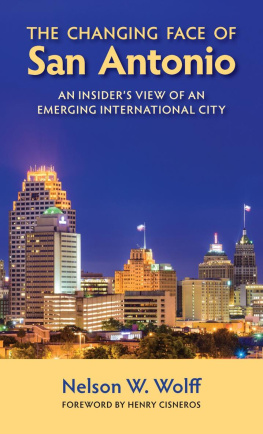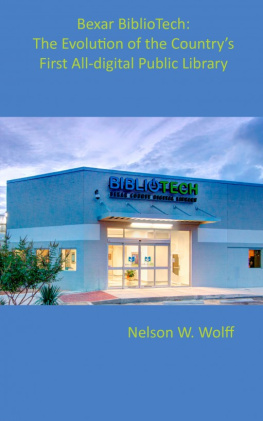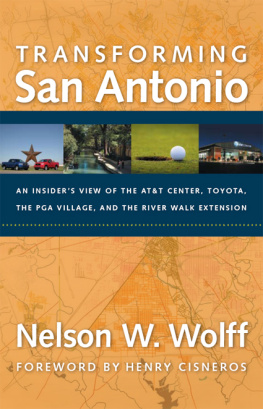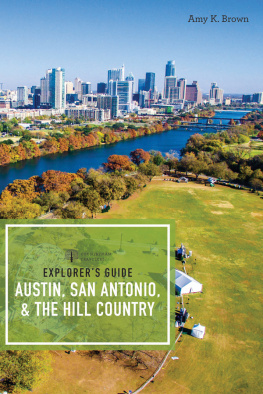Published by Maverick Books
an imprint of Trinity University Press
San Antonio, Texas 78212
Copyright 2018 by Nelson W. Wolff
All rights reserved. No part of this book may be reproduced in any form or by any electronic or mechanical means, including information storage and retrieval systems, without permission in writing from the publisher.
Book design by BookMatters, Berkeley
Cover image: iStock.com/Shaun Pavone photo
Author photo courtesy of Bexar County
ISBN 978-1-59534-847-0 paperback
ISBN 978-1-59534-848-7 ebook
Trinity University Press strives to produce its books using methods and materials in an environmentally sensitive manner. We favor working with manufacturers that practice sustainable management of all natural resources, produce paper using recycled stock, and manage forests with the best possible practices for people, biodiversity, and sustainability. The press is a member of the Green Press Initiative, a nonprofit program dedicated to supporting publishers in their efforts to reduce their impacts on endangered forests, climate change, and forest-dependent communities.
The paper used in this publication meets the minimum requirements of the American National Standard for Information SciencesPermanence of Paper for Printed Library Materials, ANSI 39.481992.
CIP data on file at the Library of Congress
22 21 20 19 18 | 5 4 3 2 1
Foreword
THE SAN ANTONIO AND BEXAR COUNTY region is prospering economically and experiencing a new level of social cohesion, which emanates from the expansion of opportunity. In the decade from July 2007 to July 2017, private sector jobs in the region increased by more than 170,000 jobsa 24.3 percent increase, the third-highest rate of job growth among US metropolitan areas. That employment momentum has made possible unprecedented levels of social mobility, residential integration, leadership sharing, and cultural respect. The region is frequently highlighted in national media as a model of multicultural inclusion and cooperative decision-making for a nation that is increasingly diverse and in need of models of collaboration. But the relationship between San Antonio and Bexar County hasnt always been a model of harmony.
San Antonio and Bexar County have a long and storied history, and much of it has been as difficult, hot, and rough-edged as the climate and topography of the region itself, which sits astride the rocky outcroppings of the Texas Hill Country and the dusty scrublands of the Texas Brush Country. The region has been fought over, survived massacres and battles, and changed hands between nations several times. It has been home to indigenous hunter-gatherers, colonizing Spaniards, nation-building Mexicans, pioneering Americans, and ambitious immigrants from every part of the world. Each group in its turn has had to endure the elements, tame the land, defend its ground, and forge an economic rationale for a region. That struggle and progression has been marked by notable historical events, from the siting of campsites along the verdant San Antonio River thousands of years ago to the arrival of Spanish explorers in 1692, the establishment of a municipal government in 1718, the municipios designation as a northern anchor of the new nation of Mexico, the Battle of the Alamo in 1836, the citys role as the largest settlement in the Republic of Texas and the new American state of Texas, and its role as an American military fort in the aftermath of the Civil War.
That challenging march of civilization was steady enough that by the early 1900s San Antonio was being compared in national publications to such other frontier centers of civilization as New Orleans and San Francisco.
But then San Antonio started to slip behind the other growing cities of what is now the Texas Triangle. Over the decades, Houston determinedly dredged a fifty-two-mile ship channel and became the energy capital of the world. Dallas assembled banking and cultural institutions and started a building juggernaut that created the imperative for DFW Airport and a global role for the Metroplex. Austin steadily converted the assets of the state capital and the flagship University of Texas into a world-class technology and innovation complex. For a fifty-year span from the 1920s to the late 1960s, San Antonio was characterized as charming but an economic laggard, colorful but divided by its politics, and quaint but hobbled by poverty. The author Sidney Lanier, who lived in San Antonio during a period of convalescence, once wrote: If peculiarities were quills, San Antonio would be a rare porcupine. By the 1950s the regions luxuriating in its distractions had produced an alarming scenario of civil strife, segregation, poverty, factionalism, inequality, and stalemate. A leading business and civic leader said in the Wall Street Journal that for San Antonio to be able to start over, the old order might have to burn to the ground.
From that nadir, the last fifty years have been a miraculous story of a region that looked into the abyss and didnt like what it saw. Leaders from every faction, social group, and ethnic heritage arrived at the same conclusion: things had to change. And since the mid-1960s change has been pursued with intentionality, leadership, tolerance, and foresight. The result has been a consensus built on two basic pillars: progressive economic development to grow jobs and wages, wealth and opportunities, and respect for social progress across rich heritagesindeed, a narrative that goes beyond people simply admiring each others roots and is in fact a new blended culture that is, simply, San Antonio.
Together they constitute a better way of living together; and of governing together, learning together, praying together, and building a city together.
The person uniquely suited by his background and temperament to shepherd this process has been Nelson Wolff. His work as county judge is the culmination of the lessons, associations, and experiences of having served as a state representative, a state senator, organizer of a state constitutional convention, a businessman, a chair of a citywide goals process, and a successful mayor. At every step Nelson has understood and advanced the two pillars of governance in this era. Boiled down to their essence they are: grow the pie so it benefits everyone, and respect everyones heritage and their right to have a place at the table.
Nelson Wolff has been the foremost public leader of the past twenty-five years in a region full of effective leaders. His contributions are on par with the greatest leaders of the regions history. His personal attributes have made the regions achievements possible. He has been determined, collegial, approachable, persuasive, and at once visionary and pragmatic.
His overarching achievement has been to transform the county government into a modern engine of competence in its basic responsibilities and catalytic investments for the future. That platform has then made possible many concrete projects over the past twenty-six years. The six initiatives reviewed in this book are examples of how public progress is created when continuity, steadiness, partnership, and the wise use of public finances are the governing principles. The initiatives touch on six core dimensions of the regions life: the identity of the San Antonio River, a modern arts venue, the regions preeminent health center, the judicial and corrections system, a technology innovation cluster, and accessible education.











